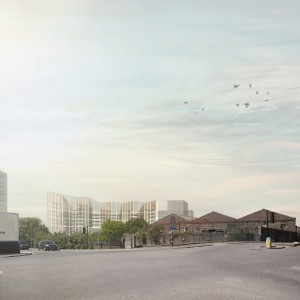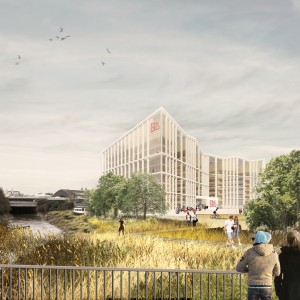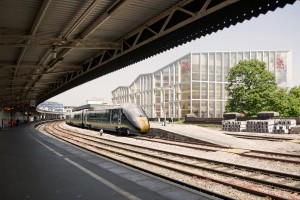The University of Bristol’s planned £300m campus next to Temple Meads railway station, which was today submitted to the city council for outline approval, will help open up the neighbouring St Philips area for redevelopment, according to the property firm working on the scheme.
One of the largest and most significant regeneration projects in Bristol’s recent history, the seven-acre campus development will transform the rundown area bordered by the station, River Avon and Feeder canal. 
The redevelopment will include demolishing the eyesore former Sorting Office building and upgrading the surrounding land with seven new buildings including a quantum technologies information centre, an innovation centre and student accommodation.
The university says this will ‘not only make a large contribution to the economy, but also improve the image of Bristol as a place to work, live and do business’ once it opens in 2021.
Kevin Hunt, director in the Bristol office of JLL, the university’s planning consultant, said the scheme will also lead to the transformation of St Philips, east of the site.
St Philips – a major residential area of the city in the Victorian era – is now mainly made up of low-level industrial buildings, warehouses, car showrooms and depots. While some heritage buildings remain, such as the grade II*-listed St Vincent’s Works, many sites could easily be demolished to make way for new housing or commercial developments.
He said: “It is great to see these plans to transform the area next to Bristol Temple Meads station move a step closer. This scheme is an excellent example of the way brownfield land should be regenerated to meet the needs of fast-growing, dynamic cities like Bristol.
“Efficient use of brownfield land by bringing forward well-balanced, high-density schemes such as this one is an important part of the mix in the creation of the sustainable cities of the future. As the population in urban areas looks set to continue rising, it is vital housing, education and employment opportunities are easily accessible. 
“This major regeneration project will also act as a catalyst for development in the wider St Philips area, paving the way for much-needed new housing and employment space to be created in the vicinity.”
In addition to building state-of-the-art education and research facilities, the University aims to create a campus that is ‘welcoming and inclusive’, to be shared with local communities, visitors to the city and with business and industrial partners alike.
University vice-chancellor and president Prof Hugh Brady said: “For the University of Bristol, the new campus provides a once-in-a-generation opportunity to reimagine the civic university. We are committed to creating a campus which both reflects our status as a world-class university and provides an open and welcoming space for the people and city of Bristol.
“Not only does the project build on Bristol’s reputation as one of the world’s leading digital cities, but it’s injecting life into a derelict site and creating unprecedented opportunities for our students and the community we’re so proud to be part of.”
He said the scheme would provide a mix of flexible research and teaching facilities including the recently announced £43m Quantum Technologies Information Centre, accommodation for up to 1,500 students and a range of commercial outlets.
Teaching and research will focus on digital technologies, their application by citizens, organisations and industry, and the  innovation they drive.
innovation they drive.
There are also plans for an innovation hub based on the successful Engine Shed model, with the aim of helping more start-up businesses to thrive.
The campus will initially cater for 3,500 students, the majority of whom will be postgraduates, and approximately 800 members of staff will be based there.
Facilities will also be opened up for public use, including a training and skills centre and resources which can be used by community groups. There’s a focus on creating an attractive destination, or through-route, for the benefit of the whole city which will include informal seating areas by the waterfront and a public art programme.
Environmental sustainability is a key priority: the campus will be car free and aims to be carbon neutral by 2030. Dedicated bus routes will connect it with the existing Clifton campus and there will also be new walking and cycle routes to connect the development with the rest of the city centre and surrounding neighbourhoods.
Many new degree programmes will be designed and developed in collaboration with industry and other partner organisations, to ensure students educated on the Temple Quarter Enterprise Campus are equipped with the knowledge, skills, values and resilience to thrive and lead in our rapidly changing world.
Aside from the business community, the university has ambitions to work with a range of other partners, from community and cultural organisations to social enterprises and the NHS.
It is working with Bristol City Council to ensure the campus complements plans for the Temple Quarter Enterprise Zone, which is one of the largest urban regeneration projects in the UK.
At this stage, the outline planning application incorporates the proposed density and scale of the buildings, as well as access to the site, rather than specific details about the appearance and layout of the new campus which will be submitted at a later stage of the planning application process.
The university is in the process of appointing a design team and, should its outline planning application be supported by the council, it will run a public consultation on its detailed plans next spring.
Architects and masterplanners on the scheme are architects Feilden Clegg Bradley Studios, the engineering consultancy is BuroHappold and the landscape consultants are Nicholas Pearson Associates – all based in Bath.
Pictured, top: How the main teaching and research building could look from Avon Street, St Philips
Pictured, centre: View of the main teaching and research building from Brock’s Bridge
Pictured, bottom: The proposed view of the campus from Platform 12 of Temple Meads station





























